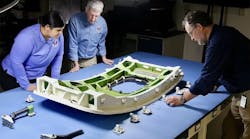The head of the National Transportation Safety Board credited the Alaska Airlines flight crew for the safe landing of a Boeing 737 MAX jet in January 2024, and criticized the aircraft builder for its failure to maintain manufacturing and safety standards that resulted in a mid-flight structural failure. Jennifer Homendy also criticized the Federal Aviation Administration for its lax oversight of Boeing and its products.
In her report, Homendy confirmed the previously reported details about the cause of the failure – principally, the fact that four critical bolts meant to secure a sidedoor panel in place in the fuselage had not been installed – and described how the failure depressurized the cabin, caused oxygen masks to drop, and sucked unsecured items out of the aircraft. Seven passengers and one crew member were injured.
The NTSB will issue several recommendations for Boeing and FAA based on the Homendy’s presentation at the Board’s meeting this week.
Notably, Homendy stated that bolts were not installed because Boeing workers had not been properly trained to perform their work in compliance with safety regulations, and had been encouraged to complete their work quickly without reference to the standards.
Further, she concluded that FAA’s oversight of the manufacturing process had been insufficient to recognize the shortcomings. FAA Administrator Michael Whitaker has previously acknowledge that agency had been lax in its oversight.
Homendy noted that Boeing has made improvements since the January 2024 incident and its consequences had been investigated, but more improvement remains to be shown.
The FAA continues to monitor activities at Boeing’s 737 MAX assembly operation in Renton, Wash., and at Spirit Aerosystems in Wichita, Kan., which manufactures fuselage assemblies for Boeing.
Boeing CEO Kelly Ortberg recently reported that FAA is expected to authorize the OEM to increase its 737 MAX production rate. Homendy noted that safety standards have improved since Ortberg assumed his role in mid-2024.
The NTSB is an independent federal agency responsible for investigating civilian transportation accidents, and in a hearing on the 737 MAX incident chairwoman Homendy recapped previously reported determinations about how the jet’s sidedoor panel had been improperly bolted during the final assembly of the recently delivered aircraft, and then cleared final inspection.
"The safety deficiencies that led to this accident should have been evident to Boeing and to the FAA," Homendy said. "It's nothing short of a miracle that no one died or sustained serious physical injuries."
She described how the 737 MAX assembly procedures had no documentation for removing and reinstalling the sidedoor panel, the design element covering the aircraft emergency exit. The panel is in place when the fuselage is assembled by Spirit AeroSystems, removed by Boeing during interior outfitting of the aircraft, and then reinstalled for final assembly.
The U.S. Dept. of Justice sought to prosecute Boeing over its failure to maintain proper safety standards, but later negotiated a plea agreement and settlement.
